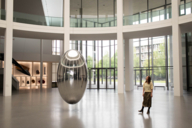
The Munich museum area “Kunstareal“ is notable for its unique concentration of top-class museums and art spaces – right at the heart of one of the city's liveliest districts. It is a celebration of the power of culture.
Do you feel like paying a visit to Rubens' grimly beautiful “Fall of the Damned”? Fancy an inspirational tête-à-tête with da Vinci's “Madonna of the Carnation”? What about sailing the seas with Dionysus? Or discussing jewellery and fashion with some Greek and Roman beauties? You can do it all. In Munich's Kunstareal (art quarter), you can wander through 5,000 years of art history.
You can marvel at the agglomerated art of the city, brought together in one place – and if that wasn't special enough, it is all nestled in the vibrant setting of Maxvorstadt, with its universities, boutiques, expansive green spaces and, above all, its cafés. Where better to draw inspiration from art?
In Munich's Kunstareal, you can start your day with Rubens and da Vinci before stopping off at the stalwart Café Puck, which has been a popular stop in Maxvorstadt for more than 30 years – once the venue for wild parties, now a place of relaxation. People meet here for lunch or coffee and cake, and perhaps rejoice in the fact that they are not 150 metres away from Museum Brandhorst, home to one of the world's most significant collections of contemporary art.
The cafe attracts a colourful mix of visitors and students, as well as culture vultures who flock to Munich's Kunstareal purely to pay tribute to the old masters.
Or why not head to Café Jasmin? The café has been in Maxvorstadt since 1955 (before that it was located on Lenbachplatz for several years) and it offers everything you could need for a little journey back in time to Munich's bohemian past: mint-green and rose-pink dominate the interior, which is also adorned with an imposing chandelier, ruffled curtains and doors covered in quilted faux leather. The original décor has been preserved and is listed for heritage protection. In the velvet armchairs here, you can dine comfortably while admiring a drawing of the castle in Bayreuth with people strolling in the park in front of it. The cafe attracts a colourful mix of visitors and students, as well as culture vultures who flock to Munich's Kunstareal purely to pay tribute to the old masters.
But the museums are also special places in and of themselves, and contain hospitality options of their own: Café Ella is a popular retreat for visitors to the Lenbachhaus art gallery, located within the museum building – indeed, as you drink in the view from the terrace, of the Propyläen (Propylaea) on Königsplatz, you might be forgiven for thinking you're still in one of the exhibition rooms.
All of these cafés and relaxation areas – and much more besides – gild the main attraction itself. Kunstareal (museum area) is one of Europe’s most prominent cultural locations, enjoying international renown and easily keeping pace with art and artists’ districts in Berlin, Vienna, Paris and New York. It's a place where you can find architectural gems, 14 exhibition houses, six internationally acclaimed universities, 32 galleries and cultural institutions – all on an area of just half a square kilometre! It’s incredible to think of. And what's more, this condensed mass of art is integrated into one of the busiest districts in the city.
Having grown continuously over a period of 200 years, Kunstareal, located between Königsplatz and Theresienstrasse, is home to a legendary collection of artworks and a history that is no less impressive – but it also epitomises the typical Munich attitude to life (serenity!) and a student-like lightness. Perhaps it is this relaxed mixture, this nonchalance, this not-setting-the-bar-too-high that embeds art so perfectly within the city. Take the green in front of the Neue Pinakothek art gallery: this is where the locals all come on Sundays to let their dogs have a run around. Couples flirt on picnic blankets, student flatmates hang up nets and play badminton. And all of that, too, is art.
This is where the locals all come on Sundays to let their dogs have a run around. Couples flirt on picnic blankets, student flatmates hang up nets and play badminton. And all of that, too, is art.
Situated on the terrace of the Technical University of Munich, Café Vorhoelzer Forum offers a view across the rooftops of Maxvorstadt that you an savour with a sundowner. Opposite stands the University of Television and Film, which has been educating the best and most successful filmmakers in the country for some 53 years. It is not just the architecture of these buildings that is impressive; in Kunstareal art can be seen everywhere, even without a ticket – it's right there on the streets.
The architecture of many museums, such as the impressive new building housing the Staatliches Museum Ägyptischer Kunst (State Museum of Egyptian Art) and the NS-Dokumentationszentrum (Munich Documentation Centre for the History of National Socialism), are attractions in themselves, even before you look at their contents. The best example is the Pinakothek der Moderne art gallery. A spectacular temple of light greets visitors on entry. There's a rotunda, designed as a public space, which also functions as a passageway. Two imposing staircases lead to the upper rooms. Here, visitors discover art before they have even entered the exhibition areas.
You can't help but stare in wonder in Kunstareal. So it makes sense then, that there’s a wonderful array of cafés and relaxation areas here inviting you to come and rest – all of them just a stone's throw from Rubens, Baselitz, da Vinci and Dionysus.